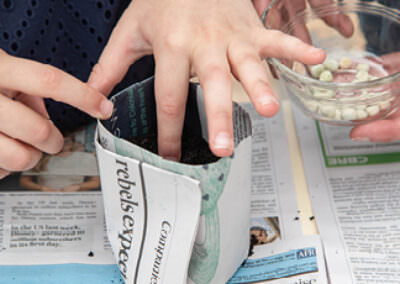STORY
Beth lives with her family in the outskirts of the city in a small property. Together, they love to grow their own fruits and vegetables. Beth loves spending a lot of time in the garden, learning about the plant cycle, and sharing her knowledge with friends. One of her favourite plants to grow are tomatoes as they are her favourite to eat. Beth enjoys the delicious fresh flavour of these juicy tomatoes in her salads and sandwiches. Her family grows tomato plants every year from seeds they save from their previous crop. Beth’s neighbours are also learning how to grow tomatoes using the seeds that her family have shared with them.

Engage young learners’ senses as they grow food from a seed. They can learn about caring for a living thing, experience the joy of watching something grow and harvesting healthy edible food. The activity provides opportunities for development of science, sustainability and maths concepts.
For children to:
- understand how plants are grown for food
- appreciate living things have needs that need to be met in order to survive and thrive
- help grow these things with care.
If there is still a chill in the air, placing pots indoors is the best way to protect your young seedlings. Follow seed labels for the optimum time to grow.
Introduction
Spring is here; the sun is out and shining so it’s time to get sowing! Plant a seed and watch your little gem grow into a seedling and then into a tasty treat ready for harvesting.
*Time allocation will be dependent on site selection and travel time.
Checklist
Instructions

STEP 1
Choose a seed to sow that is suited to your climatic zone and one that will produce fruit, vegetables or herbs for you to eat. Your seed packet will explain the best time to sow seeds.

STEP 2
Make a newspaper seed starter pot for your seedling. Tear a single sheet of newspaper in half and fold into thirds. Wrap the paper around an empty can but not too tight. Secure with tape on the side of the cylinder. Fold the paper down onto the base of the can, secure the flaps with tape. Slip your newspaper pot gently off the can. Make sure to use biodegradable or paper-based tape (e.g. masking tape).

STEP 3
Fill the seed starter pot two-thirds full with seed raising or potting mix. Carefully place your seed into the centre of the pot to a depth suitable for the specific seed and then cover with a thin layer of potting mix.

STEP 4
Your seed will need the right amount of water to germinate. Keep the soil in your seed planter pot soil moist by misting with a spray bottle every morning until it is time to plant in the ground or into a larger pot.
Extension Activity
Write or draw a checklist with the children to use to make sure they care for their seedling.
The seedling activity provides an opportunity to chat with the children about concepts such as recycling, healthy soils, pesticides and water conservation.
Curriculum and Framework Links
Reference List
ONLINE RESOURCES
Vegetable growing guide for different Australian climate zones from Gardening Australia.
Climate zones for growing food plants.
Download the Gardenate app to help plant.
Making newspaper pots – from Gardening Australia.
WATCH
Watch and learn about how seeds become plants – from ABC Education.
Enjoy this time lapse video of bean growth.
Just for Kids
Check out our fun activity Garden find-a-word.
We value your feedback
When you have finished this learning activity, please tell us what you think with our survey.
Your feedback will help Landcare Australia improve the activities in the Junior Landcare Learning Centre.
Why not try one of our other Junior Landcare learning activities?
Love Letters to the Land
Biodiversity|First Nations Perspectives|Food Production|Waste Management
Creating a food garden: vision
Food Production
Creating a food garden: planting
Food Production
Creating a food garden: installing a no dig garden bed
Food Production


